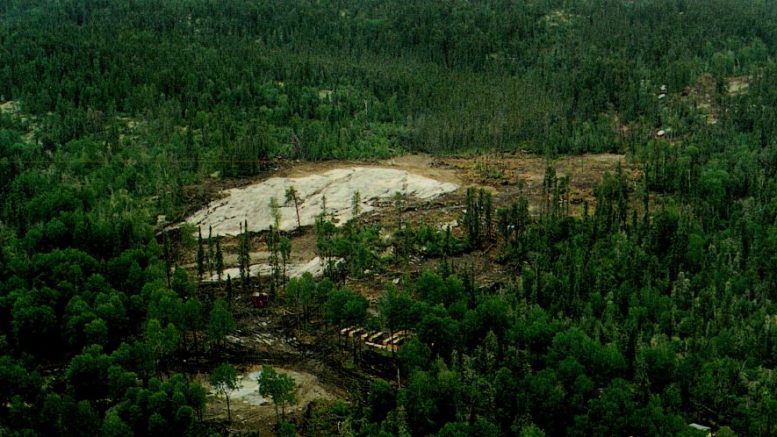Avalon Advanced Materials (TSX: AVL; US-OTC: AVLNF) has begun a new drill campaign at its wholly owned Separation Rapids lithium project, 70 km by road from Kenora, Ontario. It aims to drill seven holes totalling 1,500 metres to increase its resource.
As of a Nov. 15, 2017 resource estimate, Separation Rapids has 8.12 million measured and indicated tonnes grading 1.37% lithium oxide and 0.36% rubidium oxide.
According to a 2016 preliminary economic assessment (PEA), the 24 sq. km property could produce 14,600 tonnes of lithium hydroxide plus 100,000 tonnes of feldspar mineral concentrate per year for at least 10 years.
Total capital expense for this model was an estimated $514 million, with $86 million in contingencies and $7 million in sustaining capital. This includes the mine, concentrator and a hydromet plant in Kenora. The hydromet plant accounts for half of the total expense.

Don Bubar, president and CEO of Avalon Advanced Materials. Credit:Avalon Advanced Materials.
Avalon started working on Separation Rapids 20 years ago when it found a form of lithium pegmatite enriched in petalite — an industrial mineral used to make glass and ceramics.
“Anything that needs high strength and resistance to thermal shock — lithium is the critical ingredient,” Avalon president and CEO Donald Bubar says. “So we found this, the first such resource of this mineral ever found in North America of any consequence. And there was demand for it.”
Bubar says that at the time Corning Glass Works (NYSE: GLW) was making CorningWare cookware in North America and had been looking for a local source of lithium, but had never found one. Just as Avalon thought it was prepared to serve that market, Corning Glass Works sold its consumer products division and the new owners moved production to China. Avalon lost the market.
At the same time the lithium ion battery was emerging along with new cell phone technology. However, Avalon considered it too small of a market that was already well-served by lithium brine production in South America. So, in the early 2000s, it put the project on hold.

A sample of petalite recovered from Separation Rapids. Credit: Avalon Advance Materials.
“But even then we sensed that it would have another day — that the market in lithium batteries would grow,” Bubar says. “We didn’t think it would take 15 years, but there you go.
“That’s the whole thing with these niche market commodities. You really have to be prepared to bring a new product to market when new technology creates a new demand.”
Avalon reactivated the project in 2014 after interest in its petalites from glass manufacturers. Bubar says that while battery applications are getting all the attention, the demand for glass ceramics still exists and is growing. Manufacturers of smartphone displays and computer screens take advantage of lithium’s glass-strengthening properties to improve their products.
Avalon’s resource has two main lithium minerals: petalite, which has low levels of impurities and relatively low productions costs; and lepidolite, a purple mica. Avalon can concentrate them separately to serve different markets.
“That’s kind of the beauty of it, actually,” Bubar says.

Avalon staff at Separation Rapids during the summer 2017 drill program. Credit: Avalon Advanced Materials.
Over the past two years, Avalon has developed its own process for extracting lithium hydroxide from petalite. It wants to take the process that it developed and scale it up to pilot plant or demonstration plant scale and make product to test in the marketplace.
“The lithium mineral concentrates are much easier to produce and they’re the intermediate stage of making the battery material,” Bubar says. “It’s also a blessing for us in that it gives us a low-risk alternative for getting started by being able to produce concentrates for sale and not having to try to make the battery material straight out of the gate.”
There are also companies that can extract lithium carbonate from lepidolite.
Separation Rapids is still open at depths below 200 metres and along strike. Avalon wants to do more near-surface drilling on the lepidolite-rich areas that it didn’t focus on initially. It also intends to test the West Pegmatite zone, which is 800 metres along strike from the main deposit. It says the two zones are “very similar” in appearance.
It also wants to finish pilot work on the process flow sheets and the engineering for the phase-one plant. It would then complete either an updated PEA or a preliminary feasibility study, before trying to attract the financing to build the phase one plant.
Bubar says the plant could cost $40 to $50 million to build.
Avalon also closed a $1.5-million preferred share financing in early 2018. Part of that will go to fund the current drill campaign, which has a $500,000 budget. Since 1996, Avalon has spent $10 million on the project.
“You have to be patient these days in the mineral industry and wait for the opportunities,” Bubar says.
Avalon has several other projects, including its wholly owned Nechalacho rare earth elements project in Thor Lake, Northwest Territories. Avalon has completed a feasibility study at Nechalacho and received approval for environmental assessment.
Shares of Avalon are valued at 12¢ within a 52-week range of 11¢ to 20¢. The company has a $26-million market capitalization.


Be the first to comment on "Avalon steps up lithium hunt at Separation Rapids"